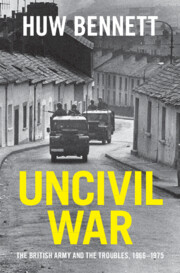Book contents
- Uncivil War
- Cambridge Military Histories
- Uncivil War
- Copyright page
- Dedication
- Contents
- Figures
- Maps
- Tables
- Illustrations
- Abbreviations
- Introduction
- 1 Baggage
- 2 The Army’s Short-Lived Ulster Honeymoon
- 3 Escalation and the Erosion of Impartiality
- 4 Edward Heath’s Bid for Victory
- 5 The Road to Bloody Sunday
- 6 The Most Deadly Year
- 7 Strategy in the Shadow of Loyalist Power
- 8 We Cannot Envisage Peace
- Conclusion
- A Note on Sources
- Acknowledgements
- Notes
- Bibliography
- Index
8 - We Cannot Envisage Peace
Published online by Cambridge University Press: 03 August 2023
- Uncivil War
- Cambridge Military Histories
- Uncivil War
- Copyright page
- Dedication
- Contents
- Figures
- Maps
- Tables
- Illustrations
- Abbreviations
- Introduction
- 1 Baggage
- 2 The Army’s Short-Lived Ulster Honeymoon
- 3 Escalation and the Erosion of Impartiality
- 4 Edward Heath’s Bid for Victory
- 5 The Road to Bloody Sunday
- 6 The Most Deadly Year
- 7 Strategy in the Shadow of Loyalist Power
- 8 We Cannot Envisage Peace
- Conclusion
- A Note on Sources
- Acknowledgements
- Notes
- Bibliography
- Index
Summary
British strategists came to accept permanent conflict in Northern Ireland because they could only imagine things being worse without them. Preparing for the long haul meant getting the army force level to a sustainable level. From mid 1973 senior officers expressed anxieties about what the repeated tours were doing to their men. Morale-sustaining measures played some part in ameliorating the fatigue. This chapter examines the debate about reductions in the military commitment as the context for understanding the Ulster Workers’ Council strike in May 1974, which condemned Northern Ireland to conflict for decades to come. The chapter argues the Ministry of Defence discouraged the Northern Ireland Office from asking for the reinforcements needed to suppress the strike. By delaying, emphasising police unreliability and presenting a catastrophe as inevitable, the ministry kept the force level down. A major arrest operation towards the end of the strike showed loyalist insurrection to be a less worrisome prospect than commonly feared. An intractable conflict was tolerable to the cabinet as in 1973–5 the character of the violence turned less ‘British’ and more ‘Northern Irish’. Successive London administrations gave confidence to those who opposed political change by the strategy of limited containment towards violent loyalism.
Keywords
Information
- Type
- Chapter
- Information
- Uncivil WarThe British Army and the Troubles, 1966–1975, pp. 247 - 270Publisher: Cambridge University PressPrint publication year: 2023
